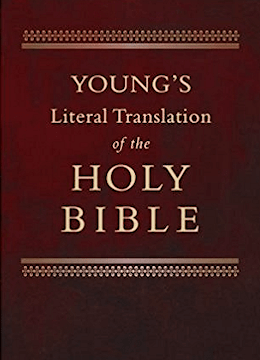Textus Receptus Bibles
Young's Literal Translation 1862
| 8:1 | On that day hath the king Ahasuerus given to Esther the queen the house of Haman, adversary of the Jews, and Mordecai hath come in before the king, for Esther hath declared what he `is' to her, |
| 8:2 | and the king turneth aside his signet, that he hath caused to pass away from Haman, and giveth it to Mordecai, and Esther setteth Mordecai over the house of Haman. |
| 8:3 | And Esther addeth, and speaketh before the king, and falleth before his feet, and weepeth, and maketh supplication to him, to cause the evil of Haman the Agagite to pass away, and his device that he had devised against the Jews; |
| 8:4 | and the king holdeth out to Esther the golden sceptre, and Esther riseth, and standeth before the king, |
| 8:5 | and saith, `If to the king `it be' good, and if I have found grace before him, and the thing hath been right before the king, and I `be' good in his eyes, let it be written to bring back the letters -- a device of Haman son of Hammedatha the Agagite -- that he wrote to destroy the Jews who `are' in all provinces of the king, |
| 8:6 | for how do I endure when I have looked on the evil that doth find my people? and how do I endure when I have looked on the destruction of my kindred?' |
| 8:7 | And the king Ahasuerus saith to Esther the queen, and to Mordecai the Jew, `Lo, the house of Haman I have given to Esther, and him they have hanged on the tree, because that he put forth his hand on the Jews, |
| 8:8 | and ye, write ye for the Jews, as `it is' good in your eyes, in the name of the king, and seal with the signet of the king -- for the writing that is written in the name of the king, and sealed with the signet of the king, there is none to turn back.' |
| 8:9 | And the scribes of the king are called, at that time, in the third month -- it `is' the month of Sivan -- in the three and twentieth of it, and it is written, according to all that Mordecai hath commanded, unto the Jews, and unto the lieutenants, and the governors, and the heads of the provinces, that `are' from Hodu even unto Cush, seven and twenty and a hundred provinces -- province and province according to its writing, and people and people according to its tongue, and unto the Jews according to their writing, and according to their tongue. |
| 8:10 | And he writeth in the name of the king Ahasuerus, and sealeth with the signet of the king, and sendeth letters by the hand of the runners with horses, riders of the dromedary, the mules, the young mares, |
| 8:11 | that the king hath given to the Jews who `are' in every city and city, to be assembled, and to stand for their life, to cut off, to slay, and to destroy the whole force of the people and province who are distressing them, infants and women, and their spoil to seize. |
| 8:12 | In one day, in all the provinces of the king Ahasuerus, on the thirteenth of the twelfth month -- it `is' the month of Adar -- |
| 8:13 | a copy of the writing to be made law in every province and province is revealed to all the peoples, and for the Jews being ready at this day to be avenged of their enemies. |
| 8:14 | The runners, riding on the dromedary, `and' the mules, have gone out, hastened and pressed by the word of the king, and the law hath been given in Shushan the palace. |
| 8:15 | And Mordecai went out from before the king, in royal clothing of blue and white, and a great crown of gold, and a garment of fine linen and purple, and the city of Shushan hath rejoiced and been glad; |
| 8:16 | to the Jews hath been light, and gladness, and joy, and honour, |
| 8:17 | and in every province and province, and in every city and city, the place where the word of the king, even his law, is coming, gladness and joy `are' to the Jews, a banquet, and a good day; and many of the peoples of the land are becoming Jews, for a fear of the Jews hath fallen upon them. |

Young's Literal Translation 1862
Young's Literal Translation is a translation of the Bible into English, published in 1862. The translation was made by Robert Young, compiler of Young's Analytical Concordance to the Bible and Concise Critical Comments on the New Testament. Young used the Textus Receptus and the Majority Text as the basis for his translation. He wrote in the preface to the first edition, "It has been no part of the Translator's plan to attempt to form a New Hebrew or Greek Text--he has therefore somewhat rigidly adhered to the received ones."